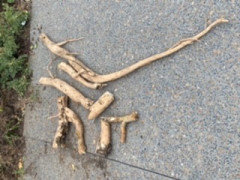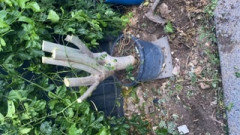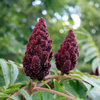Moringa oleifera/The miracle tree
I have just started growing moringa. Its only been a few days and my seeds have started to sprout! I have one now thats only an inch tall. I was wondering how fast this miracle tree actually grows? And if anyone else has had success growing it. Also I have a few seeds left over, if anyone has any other propagation tips, so that I could experiment with growing them?
Comments (9)
yiorges-z5il
14 years agolast modified: 9 years agono one seems to know the answer to your question SO>>>> why don't you keep notes on germination & growth rate etc. THEN tell what & how to grow this plant.
tropicdude
14 years agolast modified: 9 years agoI planted a Moringa seed last year, sprouted right away, and was growing fast, so I gave it to my father in law, who had a small lot with some plants, and was about 3ft tall, when a gardener that didn't recognize it, that it was a weed and pulled it out :(..
the following is from Moringa Farms.
IN THE FIELD:
If planting a large plot it is recommended to first plough the land. Prior to planting a seed or seedling, dig a planting pit about 50cm in depth and the same in width. This planting hole serves to loosen the soil and helps to retain moisten in the root zone, enabling the seedlings roots to develop rapidly. Compost or manure at the rate of 5kg per pit can be mixed with the fresh topsoil around the pit and used to fill the pit. Avoid using the soil taken out of the pit for this purpose: fresh topsoil contains beneficial microbes that can promote more effective root growth. The day before out planting, water the filled pits or wait until a good rain before out-planting seedlings. Fill in the hole before transplanting the seedling. In areas of heavy rainfall, the soil can be shaped in the form of a mound to encourage drainage. Do not water heavily for the first few days. If the seedlings fall over, tie them to stick 40cm high for support.
DIRECT SEEDING:
If water is available for irrigation (i.e., in a backyard garden), trees can be seeded directly and grown anytime during the year. Prepare a planting pit first, water, and then fill in the pit with topsoil mixed with compost or manure before planting seeds. In a large field, trees can be seeded directly at the beginning of the wet season.
GROWING FROM CUTTINGS:
Use hard wood, not green wood, for cuttings. Cuttings should be 45cm to 1.5m long and 10cm thick. Cuttings can be planted directly or planted in sacks in the nursery. When planting directly, plant the cuttings in light, sandy soil. Plant one-third of the length in the ground (i.e., if the cutting is 1.5m long, plant it 50cm deep). Do not over water; if the soil is too heavy or wet, the roots may rot. When the cuttings are planted in the nursery, the root system is slow to develop. Add phosphorus to the soil if possible to encourage root development. Cuttings planted in a nursery can be out-planted after 2 or 3 months.
SPACING:
For intensive Moringa production, plant the tree every 3 meters in rows 3 meters apart. To ensure sufficient sunlight and airflow, it is also recommended to plant the trees in an east-west direction. When the trees are part of an alley-cropping system, there should be 10 meters between the rows. The area between trees should be kept free of weeds.
Trees are often spaced in a line one meter or less apart in order to create living fence posts. Trees are also planted to provide support for climbing crops such as pole beans, although only mature trees should be used for this purpose since the vine growth can choke off the young tree. Moringa trees can be planted in gardens; the treeÂs root system does not compete with other crops for surface nutrients and the light shade provided by the tree will be beneficial to those vegetables which are less tolerant to direct sunlight. From the second year onwards, Moringa can be inter-cropped with maize, sunflower and other field crops. Sunflower is particularly recommended for helping to control weed growth.[1] However, Moringa trees are reported to be highly competitive with eggplant (Solanum melongena) and sweet corn (Zea mays) and can reduce their yields by up to 50%.[2]
PINCHING THE TERMINAL TIPS:
When the seedlings reach a height of 60cm in the main field, pinch (trim) the terminal growing tip 10cm from the top. This can be done using fingers since the terminal growth is tender, devoid of bark fiber and brittle, and therefore easily broken. A shears or knife blade can also be used. Secondary branches will begin appearing on the main stem below the cut about a week later. When they reach a length of 20cm, cut these back to 10cm. Use a sharp blade and make a slanting cut. Tertiary branches will appear, and these are also to be pinched in the same manner. This pinching, done four times before the flowers appear (when the tree is about three months old), will encourage the tree to become bushy and produce many pods within easy reach. Pinching helps the tree develop a strong production frame for maximizing the yield. If the pinching is not done, the tree has a tendency to shoot up vertically and grow tall, like a mast, with sparse flowers and few fruits found only at the very top.
For annual Moringa types, directly following the end of the harvest, cut the treeÂs main trunk to about 90cm from ground level. About two weeks later 15 to 20 sprouts will appear below the cut. Allow only 4-5 robust branches to grow and nib the remaining sprouts while they are young, before they grow long and harden. Continue the same pinching process as done with new seedlings so as to make the tree bushy. After the second crop, the trees can be removed and new seedlings planted for maximum productivity.
For perennial Moringa types, remove only the dead and worn out branches every year. Once in four or five years, cut the tree back to one meter from ground level and allow re-growth.
WATERING
Moringa trees do not need much watering. In very dry conditions, water regularly for the first two months and afterwards only when the tree is obviously suffering. Moringa trees will flower and produce pods whenever there is sufficient water available. If rainfall is continuous throughout the year, Moringa trees will have a nearly continuous yield. In arid conditions, flowering can be induced through irrigation.
FERTILIZINGMoringa trees will generally grow well without adding very much fertilizer. Manure or compost can be mixed with the soil used to fill the planting pits. Phosphorus can be added to encourage root development and nitrogen will encourage leaf canopy growth. In some parts of India, 15cm-deep ring trenches are dug about 10cm from the trees during the rainy season and filled with green leaves, manure and ash. These trenches are then covered with soil. This approach is said to promote higher pod yields. Research done in India has also showed that applications of 7.5kg farmyard manure and 0.37kg ammonium sulfate per tree can increase pod yields threefold.[3]
PESTS AND DISEASES
Moringa is resistant to most pests. In very water-logged conditions, Diplodia root rot can occur. In very wet conditions, seedlings can be planted in mounds so that excess water is drained off. Cattle, sheep, pigs and goats will eat Moringa seedlings, pods and leaves. Protect Moringa seedlings from livestock by installing a fence or by planting a living fence around the plantation. A living fence can be grown with Jatropha curcas, whose seeds also produce an oil good for soap-making. For mature trees, the lower branches can be cut off so that goats will not be able to reach the leaves and pods. Termites can be a problem, especially when cuttings are planted.
Among approaches recommended to protect seedlings from termite attack:[4]
· Apply mulches of castor oil plant leaves, mahogany chips, tephrosia leaves or Persian lilac leaves around the base of the plants.
· Heap ashes around the base of seedlings.
· Dry and crush stems and leaves of lion's ear or Mexican poppy and spread the dust around the base of plants.
In India, various caterpillars are reported to cause defoliation unless controlled by spraying. The budworm Noordia moringae and the scale insects Diaspidotus sp. and Ceroplastodes cajani are reportedly able to cause serious damage. Also mentioned as pests in India are Aphis craccibora, the borer Diaxenopsis apomecynoides and the fruit fly Gitonia sp.[5] Elsewhere in the world, where Moringa is an introduced tree, local pests are less numerous.
HARVESTINGWhen harvesting pods for human consumption, harvest when the pods are still young (about 1cm in diameter) and snap easily. Older pods develop a tough exterior, but the white seeds and flesh remain edible until the ripening process begins.
When producing seed for planting or for oil extraction, allow the pods to dry and turn brown on the tree. In some cases, it may be necessary to prop up a branch that holds many pods to prevent it breaking off. Harvest the pods before they split open and seeds fall to the ground. Seeds can be stored in well-ventilated sacks in dry, shady places.
For making leaf sauces, harvest seedlings, growing tips or young leaves. Older leaves must be stripped from the tough and wiry stems. These older leaves are more suited to making dried leaf powder since the stems are removed in the pounding and sifting process.
References
Fuglie, L., 1999. Producing Food Without Pesticides: Local solutions to crop pest control in West Africa. CTA, Wageningen, The Netherlands.
Morton, J.F. 1991. The Horseradish Tree, Moringa Pterygosperma (Moringaceae) - A Boon to Arid Lands? Economic Botany. 45(3):318-333.
Ramachandran, C., K.V. Peter, and P.K. Gopalakrishnan, 1980. Drumstick (Moringa oleifera): A Multipurpose Indian Vegetable. Economic Botany. 34(3):276-283.
Sreeja, K.V. 2001. Horti Nursery Networks, Tamil Nadu, India. Personal email of 26/03.
Warndorff, T. 2001. Personal email of 22.03.
Perdew, Rodney, President, Moringa Farms
This really is a wonderful tree, so useful and could potentially save many lives.
Related Professionals
Belmont Landscape Architects & Landscape Designers · Erie Landscape Architects & Landscape Designers · Cliffside Park Landscape Contractors · Fishers Landscape Contractors · Fort Mill Landscape Contractors · Gurnee Landscape Contractors · Hickory Hills Landscape Contractors · Lemoore Landscape Contractors · Madera Landscape Contractors · Ramsey Landscape Contractors · Salem Landscape Contractors · Tamarac Landscape Contractors · Pataskala Carpenters · Columbia Fence Contractors · Natick Fence Contractorsjas_il
14 years agolast modified: 9 years agoI have ordered some moringa seeds. I would like to know how to sprout it. Do you soak seeds? Is baggie method good for germinating seeds.
I read that if it is grown on ground and winter is not harsh it grows very quickly around 4-5 ft in an year.
Thanks a lot
vegheadgirl
Original Author14 years agolast modified: 9 years agoYes the baggie method does work! I soaked the seed for a day before putting it in the bag. After doing so, my seed started to open and I could see the folliage comming out in only 3 days! I took it out before any stems or roots started to grow out of the seed, just to be on the safe side, and planted it directly in a pot with just potting soil and perlite. Its been two or three weeks and its almost a foot tall now!
tropicdude
14 years agolast modified: 9 years agocouple weeks ago I picked some dried Moringa pods off a tree, planted them in small pots, 1 seed per pot, only one of the 8 seeds I planted did not sprout, they came up in just 4-5 days.
no soaking, no anything.these trees grow fast, in some places they grow them like veggies, they plant them in the gardenm let them get to a few feet ( just a few months ) then they harvest the whole plant.
Moringa isn't very ornamental nor is it a great shade tree. but it is very useful. and grows in poor soil.
take a look at this video of Moringa growing in a very arid and poor soil (sandy soil, rains once a year), according to the lady speaking (spanish) they reached 2 meter in 4 months.
hendrycreekhideaway
13 years agolast modified: 9 years agoIf growing Moringa in your Florida yard, plant in full sun and trim often to promote branching. Otherwise, the tree gets very tall and gangly quickly. The leaves will be so high up you won't be ble to harvest them. Cut the tree back severely in the winter. Plant the limbs to cultivate new trees; or soak them in water for weeks in the shade until planting! The bare trunk will spout new limbs in the early spring.
I like to grow Moringa in large pots on my back porch. Plant seeds each spring and keep the plants small by harvesting the leaves like herbs. When it outgrows the pots, transplant to yard or harvest the roots.
廖庆耀
4 years agolast modified: 4 years ago@zrex_adept_co_za I have seen a few huge moringa trees growing close to (less than 1 meter away from) a wall. There seemed to be no effect on the wall.
Anjila Puran
3 years agolast modified: 3 years agoI would not plant it near the house. I don’t care what people say but roots are invasive.
This I pulled out. 15 months old tree in a pot. It went through the bottom of pot









zrex_adept_co_za